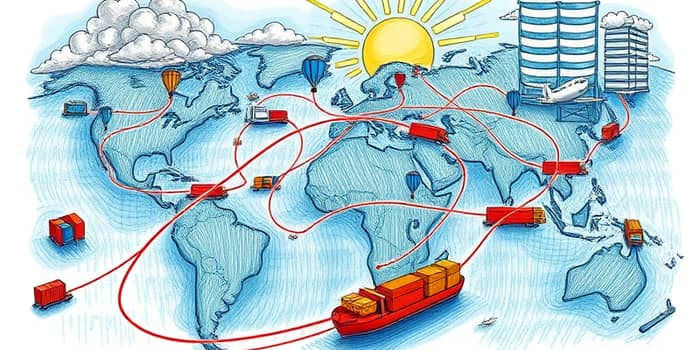In a world still recovering from the early-2020s turmoil, no company can ignore the aftershocks of COVID-19 or the fresh waves of disruption hitting global supply chains. In 2025, executives must embrace new mindsets and concrete strategies to counter threats ranging from geopolitical tensions to climate extremes. This article navigates the current landscape and provides actionable insights to drive resilience and opportunity.
Understanding Modern Supply Chain Shocks
Supply chain shocks in 2025 have become inevitable and must plan for every enterprise. Far from isolated events, disruptions now overlap, cascade, and amplify across industries and regions due to tight interconnectivity across global networks. Companies are shifting from defensive firefighting to proactive resilience planning.
From lingering pandemic impacts to new cyber threats, supply chains must adapt to diverse challenges. Embracing uncertainty and mapping potential shock scenarios are critical first steps in safeguarding operations and preserving market share.
Primary Drivers of Disruption
Complex forces converge to destabilize supply networks. Leaders must understand each driver’s unique dynamics and interdependencies:
- Geopolitical Tensions and Tariffs: In April 2025, the US imposed a 10% baseline tariff on all goods, with peaks up to 50% for some imports. Tariffs on Chinese goods briefly reached 145%, sparking global retaliation and surging spot freight rates by over 70% on key lanes.
- Climate Events: Extreme weather, from flooding in Asia to hurricanes in North America, regularly disrupts shipping schedules, crop yields, and raw material sourcing.
- Cybersecurity Threats: Logistics infrastructures face escalating ransomware attacks and data breaches, paralyzing operations and undermining trust.
- Talent and Labor Shortages: Skilled workforce gaps and labor stoppages erode capacity and inflate costs across manufacturing, warehousing, and transport.
- Regulatory Change: Emissions standards, trade rules, and customs reforms are cited by 34% of shippers as a top disruption risk in 2025.
- Commodity Market Volatility: Fluctuating prices for metals, plastics, and fibers create unpredictable input costs and production bottlenecks.
Market Impacts: Data and Realities
Statistics from 2025 illustrate the depth of the challenge. A staggering 94% of companies reported revenue and margin erosion risks due to supply chain disruptions. US automakers reliant on Chinese parts faced a 5–7 percentage-point drop in margins, with some segments experiencing declines up to 75%.
Preparedness remains uneven: only 37% of shippers and carriers feel very prepared for the year’s shocks, while 55% describe themselves as somewhat ready. The gap between ambition and reality highlights the urgent need for focused investments.
Strategies for Building Resilience
Market leaders are moving beyond stopgap fixes. They are investing in foundations that withstand shocks and create competitive advantage:
- Balanced Multi-shoring and Regionalization: 50% of companies now source from multiple regions, boosting supply reliability by 10 percentage points and reducing geopolitical risk.
- Digitization and Automation for Resilience: 74% of executives plan to increase investments in IoT, AI, and robotics to close talent gaps and enhance visibility.
- Sustainability and Environmental Focus: With 50% of consumers valuing eco-friendly practices, 40% of firms are prioritizing electrification and 29% are optimizing resource management.
- Supply Chain Financing Innovations: New programmatic finance models empower SMEs—which form the backbone of supply chains—to access capital and strengthen their resilience at scale.
Looking Ahead: Future Outlook and Opportunities
As 2025 unfolds, new threats like quantum-enabled cyberattacks and advanced logistics war-gaming loom on the horizon. Companies must balance the cost of resilience against indirect benefits such as reliability, brand trust, and long-term growth.
Freight markets are shifting mid-year to become more carrier-friendly, pressuring shippers to secure favorable contracts early. Simultaneously, foreign direct investment in key sectors—semiconductors, pharmaceuticals, clean energy—continues to reshape manufacturing footprints.
Small and medium enterprises remain the most vulnerable. Strengthening their networks through collaborative digital platforms, shared risk pools, and targeted financing can protect entire ecosystems from cascading failures.
A Call to Action
Supply chain shocks are no longer rare anomalies. They are part of the new normal, demanding bold leadership and creative solutions. By embracing strategic diversification, harnessing digital technologies, and championing sustainability, businesses can transform vulnerability into opportunity.
Every stakeholder—from C-suite executives to logistics managers—holds a piece of the resilience puzzle. Act now: fortify your networks, empower your teams, and chart a course toward a future where supply chain shocks no longer dictate success, but inspire stronger, more adaptive markets.
References
- https://forceget.com/blog/supply-chain-disruption-2025-confronting-complexity-in-global-trade/
- https://www.supplychainbrain.com/articles/41262-survey-freight-industry-prepares-for-supply-chain-shocks-in-2025
- https://procurementtactics.com/supply-chain-statistics/
- https://www.bcg.com/publications/2025/cost-resilience-new-supply-chain-challenge
- https://www.weforum.org/stories/2025/07/strengthening-manufacturing-supply-chains-new-industrial-era/
- https://www.xeneta.com/blog/the-biggest-global-supply-chain-risks-of-2025
- https://events.industrydive.com/events/supply-chain-risks-to-watch-in-2025
- https://unctad.org/publication/global-trade-update-september-2025-trade-policy-uncertainty-looms-over-global-markets










